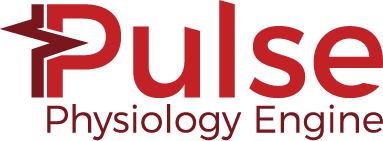Pulse Physiology 2.3.0 Release

On behalf of the Pulse Physiology Community, we are pleased to announce that version 2.3 is now available. We have continued to assist companies and universities to integrate Pulse into their projects and product goals. We have worked with these users to improve models and functionality to advance the physiology engine for their needs. To showcase our users and more, we have created a new and improved website.

The 2.3 version release includes:
- Software Architecture Improvements
- Cross compile support for building Pulse for the Magic Leap
- C# API Updates (Included in our latest Pulse Unity Asset version 2.0)
- Added Data Request support for requesting any data from the engine
- Added support for patient creation, with or without chronic conditions
- Added support for more actions
- C++ API Updates
- Created separate Initial and Current patient definitions
- Updated general math exponential functions to be more intuitive
- Added a Multiply value setting, similar to Increment
- Physiology Model Improvements
- Significant respiratory model updates
- Changed standard respiration rate from 16 bpm to 12 bpm to better match standards in literature and validation
- Modified respiratory circuit for improved modeling
- Refactored the respiratory muscle driver with a new waveform
- Added a sigmoidal chest wall compliance model
- Refactored respiratory conditions and actions for improved restrictive and obstructive disease results and combined effects
- Added an ARDS condition
- Added a pulmonary fibrosis condition
- Added exacerbation action to degrade/improve respiratory conditions during simulations
- Renamed apnea action to dyspnea
- Refactored conscious respiration, leading to improved spirometry curves
- More/better validation
- Patient lung volumes are now determined using ideal body weight rather than actual body weight
- Updated anesthesia machine circuit to use pressure sources for supplying gas, rather than flow sources to avoid issues with flow source pressure calculations
- Significant respiratory model updates
Our refactored and significantly improved respiratory system methodology meets the expanded validation more accurately. Updates to pathophysiology models provide much better performance for restrictive and obstructive disease states.
This release includes a new pulmonary fibrosis condition implemented by the Health Care Engineering Systems Center at the University of Illinois at Urbana Champaign.
In the coming months, we are working to improve and extend Pulse with:
- Sepsis
- Hemorrhagic shock and improved hemorrhage methodology for better performance and usability
- A second order baroreceptor model
- Work of breathing and respiratory fatigue models
- Circuit/Compartment black boxing to support modularity for system/model/circuit swapping
- Python bindings
- Pediatric physiology prototype
- An official contribution guide for merge requests for methodology/model changes
This release includes a number of changes contributed from our expanding community, special thanks go to :
- Hongpeng Liu for fixing a CMake bug
- Mattias Lantz Cronqvist for fixing a C# bug
- Anusha Muralidharan for implementing a new pulmonary fibrosis model
For more information on our efforts and our users, visit our new and improved website or sign up for our newsletter. If you would like to feature your Pulse use case, please email us at kitware@kitware.com.